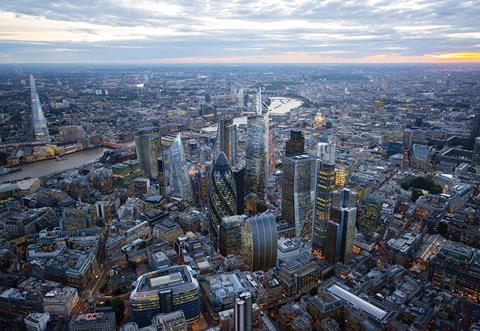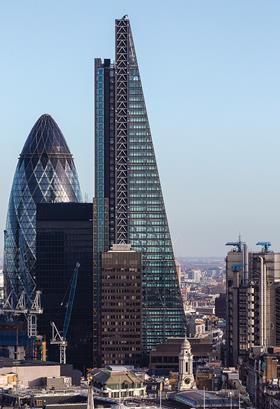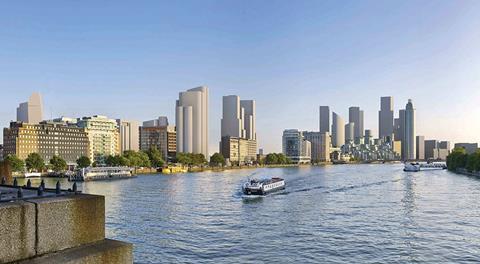With nearly 250 towers set to be built in London alone - the vast majority of them residential - Brian Smith, Mital Dholakia and Richard Heseltine of Aecom highlight the main design and cost considerations in reaching for the skies

01 / Introduction
The UK, and London in particular, is developing an increasing number of towers. A recent study by New London Architecture (NLA) highlighted that there are nearly
250 towers of 20 storeys or more either being constructed or proposed in London alone.
The last decade witnessed iconic commercial towers built in and around the city. In the next wave, however, the NLA study has identified 80% of towers as residential.
This phase is expected to see architects striving for a balance between rational design and elegant form, as developers seek improvement in efficiency to deliver viable schemes. Understanding the key value drivers is therefore as important as ever.
Whatever the form, there are still challenges in developing towers: they take longer to get to site - especially those that require lengthy planning periods - take longer to construct, cost more and are less efficient than lower rise buildings.
These issues are offset by the higher density of development and the sales/rental values that can be achieved. Strong demand for residential towers, especially for the high-end market, has seen growth in sales prices, which continues to encourage the supply side of the market.
Towers need to be flexible to cope with changes in regulations and the product required by the market. The commercial office market needs to respond to the challenge of increased occupational density, if only on some of the lower floors, and dealing with different types of occupiers.
Companies with large space requirements are being attracted to the recent City towers, along with firms who have smaller demand and who traditionally took this space. Both seek the prestige of taking space in an iconic tall building.
The specification for residential schemes has also evolved to reflect market and purchaser requirements. For example, additional air-conditioning, underfloor heating, security features and specification of the kitchen fit-out are now regularly considered and implemented within designs.
02 / Design and construction challenges
The fundamentals behind tower design, regardless of signature design or functionality, remain the same. They need to maximise area, provide it for the lowest cost and complete construction in the shortest time. With a large amount of repetition, time should be dedicated to getting the concept and then the details correct on those elements that contribute most to the overall cost.
Driving this efficiency should be a continuous process, as incremental improvements have a positive impact on the overall viability of the scheme. The shape of the building plays a fundamental part in driving efficiency, and there is a balance to be found between efficiency of floor plates and interesting building form to create the unique selling point.
Structure
The shape and size of the floor plate and the tower form have a direct impact on the structural design. More complicated floor shapes and forms increase the cost of the structure - both in terms of fabrication and construction. Focusing on optimisation of the structure, in order to reduce the amount of material used, needs to be balanced with other requirements such as floor spans and buildability where material choice influences the speed of construction.
Facade
A wide range of architectural solutions exist for the facade, depending on the aesthetic and performance requirements. Consequently, there can be a broader cost range depending on the system selected.
The wall-to-floor ratio - the amount of cladding required for every square metre of gross floor area - is an important metric in determining the efficiency of a floor plate. Complex shapes and articulated designs have a higher wall-to-floor ratio, which increases the facade cost - and which is compounded if the facade’s unit cost rate is also high.
Due to their size and inherent tower design, the facade package is often one of the largest cost elements on a scheme. But this does present the opportunity to take advantage of economies of scale to improve the overall cost.
The facade design sequence for a new tower is determined initially by the building energy model. The model will establish the performance requirements of the facade and inform the ratio of transparency and solid elements. If no alternative (renewable) energy source is available, the facade would most likely need to be designed as triple glazing to meet the U- and g-values determined by the model. City commercial towers such as the Leadenhall ��ɫ����TV and the Shard are good examples where the U- and g-values are achieved using a ventilated triple glazed system and also using blinds inside the cavity.
In the facade design sequence, attention should be paid to not affecting light transmittance (daylight) by reducing the g-value too much. Development in applied coatings, such as triple silver high performance coating on glass, does help to increase the light transmission value. However, this usually increases the cost of the glazing units.
Unitised facade systems are used extensively on tall buildings for a variety of reasons: off-site manufacture, quality control, programme, access requirements (no scaffolding) and performance. Typically, unitised panel systems are based on a 1.2-1.5m wide grid and by storey height. The system can be designed and built to meet the higher thermal performance required, and in the last two years we have seen the introduction of ultra-slim vacuum insulated panels (VIP) to achieve this.
Lifts
Resolving the lift strategy is a key aspect in determining the core size and layout. The development of destination hall control, double-decker lifts and increased speeds have helped optimise performance and the space taken by lifts.
But increased occupational density of floors is also a driver that has an impact on the number of lifts required. This brings additional costs to the lifts, and perhaps more importantly, takes up further net space.
Higher towers optimise the space taken by lifts with transfer lifts and sky lobbies, which some designers use as a feature, if the core is not centrally located. Observation decks and other uses, either through planning requirements or zoning floors to generate additional revenue, leads to these floors being serviced by dedicated express lifts. This enhances the customer experience and avoids a mix between visitors and occupiers. However, all these design aspects add pressure to core size.
MEP services
The building’s specification, combined with its interface and distribution throughout the building, are key drivers for the MEP design. The services strategy should be carefully considered at the outset, as changes later on are difficult to incorporate. Interface with the facade determines many of the services requirements, such as how the building deals with issues like solar gain for example.
Plant floor location influences the MEP cost, with options of central or decentralised plant. Depending on the floor plate design and location of the core and risers, it is possible to locate air-handling units on a floor-by-floor basis. Although the plant is more expensive for this option, there is potential gain by mitigating the amount of expensive basement space or reducing the amount of intermediate plant floors.
Office schemes also tend to have additional capacity and resilience built into the services solutions for future tenant requirements because plant space is at a premium. Consequently, only very limited space is available for tenants’ plant.
Current regulations treat tall buildings no differently to others: they need to meet Part L of the ��ɫ����TV Regulations as well as the Greater London Authority requirements (in central London) for renewable obligations. Tall buildings have the added issues of increased hydraulic pressure and heat exchangers leading to additional pumping requirements and therefore power usage. Adding physical renewable energy sources is constrained by limited available space; efficient use of plant and equipment therefore has greater importance, along with metering and controls.
Programme and off-site prefabrication
Overall development programmes for towers are longer than low-rise buildings through the design and construction process. Their construction sequence needs to be optimized at the outset and early buildability advice should be sought. Off-site prefabrication and modular construction of components can help by reducing the amount of site labour and materials delivered.
The Leadenhall ��ɫ����TV achieved 85% prefabrication and off-site construction when measured by the building’s construction value. Additionally, these construction processes helped to mitigate noise and disruption to neighbours, while also increasing on-site safety.
Delivery of the works influences the procurement strategy. For example, splitting out early enabling and basement works may improve the longer construction programmes associated with tower construction.

03 / Key drivers of tall buildings
The development of tall buildings in London and the UK is evolving. Over half of the towers in London proposed or being constructed are under 30 storeys. Due to the prevailing landscape, these heights represent “tower” development in London; in other cities with established tower skylines they are not considered as excessively high. Will we continue to see towers in London around this height, or will the city and country embrace and support taller buildings than those currently proposed? If so, what are the drivers for developing higher?
Planning
Planning policy dictates where tall and higher density development is allowed and encouraged, along with its extent. Attitudes vary in different London boroughs with respect to tower development. Those that have identified areas for regeneration have encouraged tower development. Nine Elms, Southwark, Greenwich, Tower Hamlets and other hubs outside central London in Croydon and Brent Cross are now seeing higher rise schemes either in construction or being proposed.
In modern times tower developments are largely new additions to the cityscape. Accordingly, the design quality to achieve planning approval has been high. Will it continue to be so in these areas of development as towers become the new norm, and will the next cycle of towers need to go higher to set themselves apart?
In the more historic city centres, towers need to respect and respond to their surroundings. This can mean that designs need to work with constrained sites restricting the size of the footprint, as well as wider policies such as height limits and viewing corridors such as those around St Paul’s cathedral in London.
Planning policy can also control the density and height of development. Section 106 agreements dictate that issues such as the amount of affordable housing and open play space requirements need to be factored into development appraisals. Through these payments towers make contributions to ground level and public space, and contribute to infrastructure improvements.
Design and efficiency
Although towers tend to be less efficient than low-rise buildings, there are design and engineering solutions that allow towers to be developed economically at heights greater than we are seeing in the UK. According to the Council of Tall ��ɫ����TVs & Urban Habitat (CTBUH), there were 154 towers over 150m in height - about 40 storeys - completed in 2013 around the world.
Increasing the height adds to the requirements for core size, lifts, sky lobbies and plant floors, all of which contribute to reductions in the net area. As towers rise in height, the size of structural zones also increases as a proportion of the overall floor plate, due to greater wind loads and core requirements. Regularity of floor plate, with simple extruded shapes repeated on each floor, helps to optimise the net-to-gross floor area and the wall-to-floor ratio of the facades.
Values required
Where tall buildings are still treated as a premium product, height generates higher value. The relationship is stronger on residential towers where higher apartments enhance the sales value, often driven by views and the exclusivity of living in a tall building. A similar relationship exists for offices, although the general market has more of an influence than height.
04 / Offices vs residential
The cost model on the following page has been prepared for a residential scheme in central London. The mid-range position of a central London office tower completed to category A standard typically costs £2,700-3,330/m2. Although this is within the range of the fitted out residential tower, there are large differences in the fit-out and the shell and core costs.
A typical office tower completed to shell and core is around 50% more expensive than a residential scheme. This is a result of the difference in key design aspects of residential and office towers.
- Floor plate design To optimise efficiencies, the floor plate size on a residential tower is around 600-750m2. The final size depends on the mix and size of units included to suit the target market. Smaller floor plates work with a central core, as can larger multi-core floor plates, but normally at the expense of overall net-to-gross and wall-to-floor ratio efficiencies. For the same reasons the minimum average office floor plate is normally around 1,500m2.
- Structure Residential schemes tend to be all-concrete structures for acoustic reasons. Post-tensioned slabs can also be considered, as lower slab thickness and storey height can provide an additional floor in the overall height of the building. But these need to be factored against buildability issues and the ability to fix layouts as early as possible. Offices tend to be constructed in steelwork combined with a concrete core to give greater spans and column-free space to the floor plate.
- Facades The use of the facade as part of the apartment on residential schemes results in the need to incorporate balconies or winter gardens, which will require additional detailing along with double-aspect apartments for schemes of higher value.
- Fit-out The fit-out cost of residential schemes is closely linked to the set sales values. For this reason, there is a big range in the specification and cost of a residential fit-out. Conversely, office schemes are normally completed to shell and core with a cost to category A fit-out on a few typical floors, and the final fit-out works undertaken by the tenant.

05 / Cost model
The cost model is based on a 30-storey private residential tower in central London. The tower has 95 apartments and a gross internal area above ground of 21,000m2. The net-to-gross ratio is 77%. Substructure costs allow for tower foundations but exclude basement levels associated with car parking and ancillary plant space as these are influenced by individual site constraints and how the tower fits into the development of the wider site.
Facilities such as gym, spa and cinemas for exclusive use by residents are also excluded from the cost model. The cost model allows for shell and core and fit-out of the residential units based on a sales value of £1,400-1,600 per ft2 of net internal area.
The following assumptions have been made:
- The costs of site preparation, external works and external services are not included
- Professional fees, statutory fees and VAT are not included
- Costs are given at first quarter 2014 based in central London and assume a competitive tender process
- Costs for enhancements to suit tenant requirements or changes are excluded.

Acknowledgements
The authors would like to thank Tom Venables of Aecom Planning, Will Macdonald of Aecom Façade Consultancy and Florentino Bercasio of Aecom Engineering Services Cost Management for their help in writing this article.
























2 Readers' comments